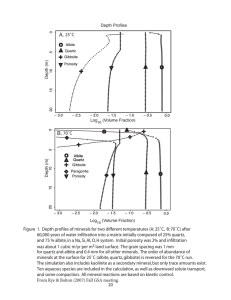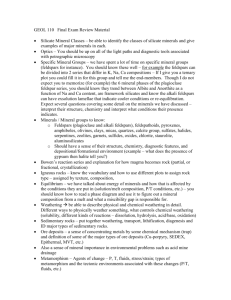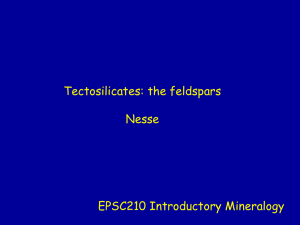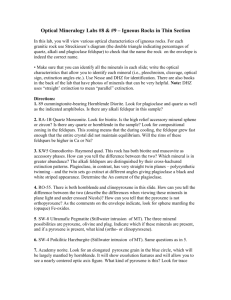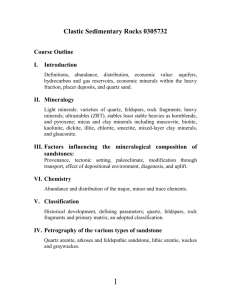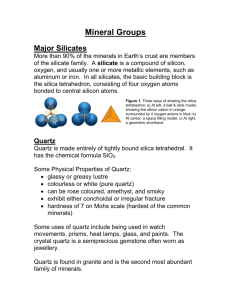GY 302: Crystallography & Mineralogy Lecture 26: Class VIII-Silicates
advertisement
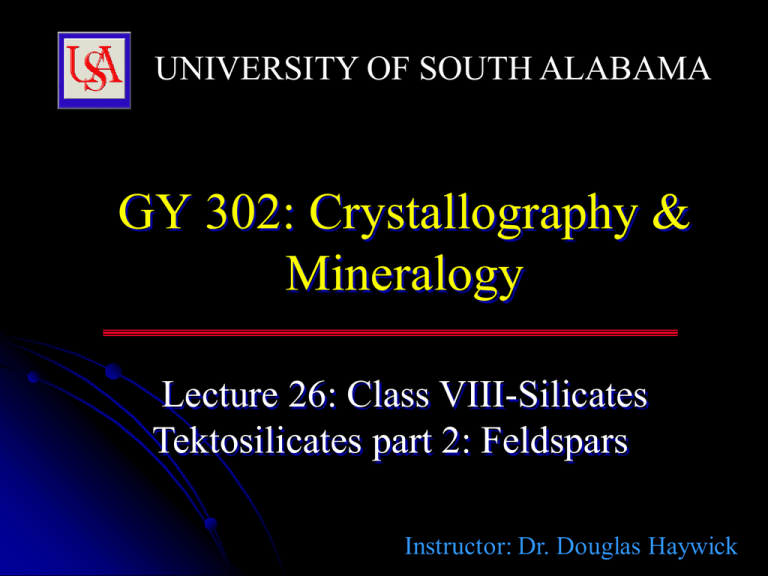
UNIVERSITY OF SOUTH ALABAMA GY 302: Crystallography & Mineralogy Lecture 26: Class VIII-Silicates Tektosilicates part 2: Feldspars Last Time Class VIII Minerals (Tektosilicates) 1. Quartz Group Tektosilicate Minerals Mineral Quartz Group Quartz *Cristobalite Coesite Chalcedony Opal crystalline” *”Chert” Formula System SiO2 (multiple varieties) SiO2 SiO2 SiO2 SiO2·nH2O Trigonal Tetragonal Monoclinic “non crystalline” “non SiO2 (multiple varieties) “non crystalline” Basic chemical composition: SiO2 Tektosilicate Minerals (Quartz Group) Quartz [SiO2] Crystal: Hexagonal (Trigonal) Pt. Group: 32 Habit: bipyramidal, massive, drusy etc. SG: 2.65; H: 7 L: vitreous; Str: colourless Col: colourless (varied) Clev: poor [0110] Optics: Uniaxial (-); bir=0.009 nw=1.544; ne=1.553 Occurrence: widespread http://webmineral.com Name Derivation: From the German “quarz” of uncertain origin Quartz Varieties [SiO2] Agate - banded variety of chaledony Amethyst - purple Avanturine - translucent chalcedony Carnelian - flesh red chalcedony Cat's Eye - chatoyant Chalcedony - microcrystalline quartz Chert - cryptocrystalline quartz Chrysoprase - apple green chalcedony Citrine - yellow Flint - microcrystalline quartz Hornstone - flint Jasper - red or brown chalcedony Moss Agate - variety of chaledony Plasma - green chalcedony Prase - leek green chalcedony Rock Crystal Rose Quartz - rose colored Sapphire Quartz - blue colored Smoky Quartz - brown to black Tiger Eye - entombed asbestos http://webmineral.com Tektosilicate Minerals (Quartz Group) “Chert” [SiO2] Crystal: N/A Pt. Group: N/A Habit: microcrystalline SG: 2.09-2.65; H: 5.5 to 7 L: dull, waxy; Str: white Col: varied Clev: none Optics: N/A Occurrence: sedimentary http://www.uky.edu/KGS/rocksmn/images/chert_var.jpg Chert is a rock name. Numerous varieties of chert have been identified. Tektosilicate Minerals (Quartz Group) Lechatlerite (“Fulgurite) [SiO2+ contaminants] Crystal: N/A Pt. Group: N/A Habit: Amorphous? SG: 2.20; H: 7.0? L: dull; Str: white Optics: N/A Col: white Clev: none Occurrence: lightning strikes http://www.mindat.org/gphotos/0707699001129998806.jpg Lightning strikes may pass 1,000,000 volts of electricity into the ground fusing quartz sand into “glass”. Six Quartz Polymorphs Displacive polymorphic transformations require relatively minor changes in the crystal lattice (e.g., modification of α, β or γ crystallographic angles). There is generally no change in energy at the transformation threshold so polymorphic transformations are instantaneous and reversible. β-quartz α-quartz If you heat “quartz” above 600 ºC it transforms to the αpolymorph (also known as high quartz). When the temperature falls below 600ºC it transforms back to the β- polymorph (also known as low quartz). Quartz Phase Diagrams Olivine-Enstatite-Quartz System Quartz: Last Words Except for 2 situations: 1) Nephaline*-bearing rocks NaAlSiO4 + 2SiO2 → NaAlSi3O8 (albite) 2) Corundum-bearing rocks Al2O3 + SiO2 → Al2SiO5 (Sil/And/Ky) * A feldspathoid; you’ll hear about these next time Today’s Agenda Class VIII Minerals (Tektosilicates) 1. Feldspar Group Tektosilicate Minerals (Feldspars) Mineral Formula System Potassium Feldspar Group Sanidine KAlSi3O8 Orthoclase KAlSi3O8 Anorthoclase (Na, K)AlSi3O8 Microcline KAlSi3O8 v. Amazonite KAlSi3O8 Monoclinic Monoclinic Triclinic Triclinic Triclinic Plagioclase Feldspars Albite (Ab) Oligoclase Andesine Labradorite Bytownite Anorthite (An) Triclinic Triclinic Triclinic Triclinic Triclinic Triclinic NaAlSi3O8 An10-30 An30-50 An50-70 An70-90 CaAl2Si2O8 The Feldspars General Formula: XAlSi3O8 or XAl2Si2O8 X= Ca2+, Na+, K+ Two Varieties: 1) Alkali Feldspars (incl Orthoclase Group) 2) Plagioclase Feldspars Tektosilicate Minerals (Feldspars) Feldspars are common igneous minerals http://depthome.brooklyn.cuny.edu/geology/core332/geofield.htm Tektosilicate Minerals (Feldspars) Feldspars are also common metamorphic minerals http://depthome.brooklyn.cuny.edu/geology/core332/geofield.htm The Feldspars Alkali Feldspars 1) Orthoclase (incl. Adularia/Moonstone) KAlSi3O8 2) Microcline (incl. Amazonite) 3) Sanadine (Na, K, Ca<0.2)(Al, Si)4O8 4) Anorthoclase NaAlSi3O8 5) Albite We will group Albite in with the plagioclases The Feldspars solid solution Plagioclase Feldspars (NaAlSi3O8-CaAl2Si2O8) 1) Albite (Ab) = NaAlSi3O8 2) 3) 4) 5) 6) Anorthite (An) = CaAl2Si2O8 Na-plagioclase (from GY 111) Ca-plagioclase The Feldspars solid solution Plagioclase Feldspars (NaAlSi3O8-CaAl2Si2O8) 1) Albite (Ab) = NaAlSi3O8 2) Oligoclase Na0.9-0.7Ca0.1-0.3AlSi3O8 3) 4) 5) 6) Anorthite (An) = CaAl2Si2O8 The Feldspars solid solution Plagioclase Feldspars (NaAlSi3O8-CaAl2Si2O8) 1) Albite (Ab) = NaAlSi3O8 2) Oligoclase Na0.9-0.7Ca0.1-0.3AlSi3O8 =(An10-30) 3) 4) 5) 6) Anorthite (An) = CaAl2Si2O8 The Feldspars solid solution Plagioclase Feldspars (NaAlSi3O8-CaAl2Si2O8) 1) Albite (Ab) = NaAlSi3O8 (An0-10) 2) Oligoclase = An10-30 3) Andesine = An30-50 4) Labradorite = An50-70 5) Bytownite = An70-90 6) Anorthite (An) = CaAl2Si2O8 The Feldspars Plagioclase Feldspars (NaAlSi3O8-CaAl2Si2O8) Determination of plagioclase composition via twinning extinction angles Tektosilicate Minerals (Feldspars) Tektosilicate Minerals (Feldspars) Anorthoclase is an interesting mineral. It forms at temps above 600 ºC followed by rapid cooling. Tektosilicate Minerals (Feldspars) Anorthoclase is an interesting mineral. It forms at temps above 600 ºC followed by rapid cooling. If the rate of cooling is slow, exsolution (separation into 2 mineral phases occurs). Anorthoclase (600 ºC) Perthite Albite “blebs” in orthoclase Antiperthite Orthoclase “blebs” in albite Tektosilicate Minerals (Feldspars) Anorthoclase is an interesting mineral. It forms at temps above 600 ºC followed by rapid cooling. If the rate of cooling is slow, exsolution (separation into 2 mineral phases occurs). Perthite Albite “blebs” in orthoclase Tektosilicate Minerals (Feldspars) Phase diagrams to the rescue! Tektosilicate Minerals (Feldspars) Phase diagrams to the rescue! Tektosilicate Minerals (Feldspars) Phase diagrams to the rescue! Tektosilicate Minerals (Feldspars) Phase diagrams to the rescue! Tektosilicate Minerals (Feldspars) Phase diagrams to the rescue! Tektosilicate Minerals (Orthoclase Group) Orthoclase (Adularia/Moonstone) [KAlSi3O8] Crystal: Monoclinic Pt. Group: 2/m Habit: prismatic, blocky SG: 2.56; H: 6 L: vitreous; Str: colourless Col: pink, white, grey-green Clev: perfect [001], good [010] Optics: biaxial (-); bir=0.005-0.006 nα=1.518; nβ=1.522, nγ=1.523 http://webmineral.com From the Greek orthos - "right" and kalo -" I cleave" Occurrence: Felsic igneous rocks, metamorphic rocks (greenschist and above) Tektosilicate Minerals (Orthoclase Group) Sanidine [KAlSi3O8] Crystal: Monoclinic Pt. Group: 2/m Habit: prismatic, blocky SG: 2.52; H: 6 L: vitreous; Str: colourless Col: colourlesss, white, grey (red) Clev: perfect [001], good [010] Optics: biaxial (-); bir=0.006-0.007 nα=1.518; nβ=1.523, nγ=1.525 http://webmineral.com From the Greek sanis - "little plate" and idos - "to see." Occurrence: high temperature felsic igneous rocks Tektosilicate Minerals (Orthoclase Group) Microcline (Amazonite) [KAlSi3O8] Crystal: Triclinic Pt. Group: 1 Habit: prismatic, blocky SG: 2.56; H: 6 L: vitreous/pearly; Str: colourless Col: bluish-green, white, grey Clev: perfect [001], good [010] Optics: biaxial (-); bir=0.007 nα=1.518; nβ=1.522, nγ=1.525 Occurrence: granite pegmatities http://webmineral.com From the Greek mikron - "little" and klinein - "to stoop." Tektosilicate Minerals (Plagioclase Group) Albite (Clevelandite) [NaAlSi3O8] Crystal: Triclinic Pt. Group: 1 Habit: prismatic, blocky SG: 2.62; H: 7 L: vitreous; Str: colourless Col: white (greyish, greenish, bluish) Clev: perfect [001], good [010] Optics: biaxial (-); bir=0.007 nα=1.518; nβ=1.522, nγ=1.523 Occurrence: granite pegmatities etc. http://webmineral.com From the Latin, albus, in allusion to the common color. Tektosilicate Minerals (Plagioclase Group) Oligoclase (Sunstone) [An10-30] Crystal: Triclinic Pt. Group: 1 Habit: massive, blocky SG: 2.65; H: 7 L: vitreous; Str: colourless Col: white (grey, brown, yellow) Clev: perfect [001], good [010] Optics: biaxial (+); bir=0.009 nα=1.533; nβ=1.537, nγ=1.542 Occurrence: granite pegmatities etc. http://webmineral.com From the Greek, oligos and kasein, "little cleavage.“ Tektosilicate Minerals (Plagioclase Group) Labradorite (Spectrolite) [An50-70] Crystal: Triclinic Pt. Group: 1 Habit: granular, blocky striated) SG: 2.69; H: 7 L: vitreous; Str: colourless Col: colourless, grey (irridescent) Clev: perfect [001], good [010] Optics: biaxial (+); bir=0.009-0.010 nα=1.554; nβ=1.559, nγ=1.562 Occurrence: Mafic igneous rocks, some metamorphic rocks http://webmineral.com From the Greek, oligos and kasein, "little cleavage.“ Tektosilicate Minerals (Plagioclase Group) Anorthite (Indianite) [An] Crystal: Triclinic Pt. Group: 1 Habit: euhedral-blocky striated) SG: 2.73; H: 6 L: vitreous; Str: colourless Col: colourless, white, grey (reddish) Clev: perfect [001], good [010] Optics: biaxial (-); bir=0.011-0.012 nα=1.572; nβ=1.579, nγ=1.583 Occurrence: Mafic igneous rocks, some metamorphic rocks http://webmineral.com From the Greek, an + orthos, "not upright" in allusion to the oblique crystals. GY 302: Crystallography and Mineralogy Lecture 26: Silicates 9: Feldspars Instructor: Dr. Doug Haywick dhaywick@southalabama.edu This is a free open access lecture, but not for commercial purposes. For personal use only.




